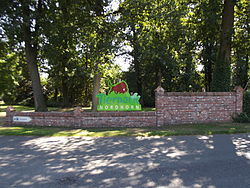Nordhorn
It is the district seat of Grafschaft Bentheim in Lower Saxony's southwesternmost corner, near the border with the Netherlands and the boundary with North Rhine-Westphalia.Since a settlement with a harbour arose between Schüttorf and Emlichheim in the Early Middle Ages whose coat of arms bore a horn as a charge, it seems likely that Nordhorn could have arisen from this.A more fanciful story holds that the locals once worshipped the god Nod, Node or Nothe, the beginning of whose festival was heralded by blows on ox and cow horns.Blumensiedlung In the 1920s, a plan was undertaken to build houses for jobless miners from the Ruhr area hired for the textile industry, and for young Nordhorn families.Stadtflur In earlier centuries, Nordhorn's townsfolk had so-called peat cutting rights in this area, which at that time was moorland belonging to the community of Bakelde.Archaeologists come across traces of Iron Age settlements, the foundations of later farming communities such as Frensdorf, Bookholt, Altendorf, Hesepe and Bakelde, in almost every field.From 12 BCE to 10 CE, the Roman commanders Drusus, Tiberius, Germanicus and Varus undertook in all thirteen campaigns in what was then still free Germany.Since modern land reclamation projects have been put in place, the river flows north of Zwolle into the Zwarte Water, which itself empties into the IJsselmeer, the lake that arose from the old Zuider Zee once the Afsluitdijk was completed.The returning ships brought spices, textiles, paper, and foods as well as luxury articles such as coffee, tea, cacao, and tobacco.Shipping on the Vechte and the canals (the Ems-Vechte-Kanal, the Nordhorn-Almelo-Kanal, the Süd-Nord-Kanal and the Coevorden-Piccardie-Kanal) together with the transported goods formed an important source of earnings at this time, when the town was also home to wealthy merchants, shipowners and mariners.During the Thirty Years' War, Swedes, Hessians, Lüneburg troops and Imperial forces passed through Nordhorn on the old Flemish army and trade road.Adolf Pazdera and Ferdinand Kobitzki, Nordhorn KPD functionaries and trade union secretaries, were persecuted many times and in 1943 and 1944 respectively, they were murdered in concentration camps.After the World War II ended, nearly ten thousand people from Germany's lost eastern territories poured into Nordhorn, where they found a new home, soon bringing the town's population to more than 40,000.The three-naved Late Gothic market church was built out of Bentheim sandstone and with its 71-m-high steeple, it dominated the town's skyline.After cautious renovations, the building now houses an ecumenical educational and meeting place whose origin and basis the unusually broad mix of faiths in Nordhorn and its environs is.Among examples of Romanesque sculpture is this church's baptismal font, which is Nordhorn's oldest artwork, made out of Bentheim sandstone, and still holds its original importance today.Behind the two-story classicist façade, the triangular gable with its hipped roof and a round-arched window with a plaster swag, the tradition of Nordhorn's first apothecary lives on.A walk through Nordhorn will in many places also still bring to light signs of the recent and more distant past, be it the town hall completed in 1952 with its little belltower or the old well at the park at the Völlinkhoff.Memories of a time when the heavy blocks of sandstone used in the oil mill's edgerunner still fulfilled their original function are brought forth at the town park.In the early 1950s, Professor Emanuel Lindner, lecturer at Bauhaus and student of Mies van der Rohe, together with architect Eberhard Heinrich Zeidler, who now lives in Canada, designed expansion building works for this business.The canals, built more than 100 years ago for transport and draining the moorlands, now form part of a faunal habitat with many species and are now used for leisure and recreation.Sluices made out of sandstone and clinker, some still worked by hand, separate different water levels and are popular destinations for nature lovers.The retailers feared that the glut of new premises would bring about further vacancies, especially in the southern inner town, while professionals criticized the consequences for urban development, the lack of cleanup operations and above all the demolition of factory buildings that were protected as monuments.Despite 12,000 Nordhorners' protest signatures gathered by the Pro Grafschaft initiative, the project was endorsed by a majority of the local politicians and in the end put into action.The Nordhorners' fondness for the Fietse and their morning rides led to the building of a special cycling path network that runs throughout the district of Grafschaft Bentheim.In the mill's building are found, alongside the county brewhouse, a musical pub for live acts and also Ems-Vechte-Welle, a regional radio station for Grafschaft Bentheim and the Emsland.Concerts were held in the barn, and still are, with such acts as Cochise, Geier Sturzflug, Helge Schneider, Killerpilze, Wir sind Helden and In Extremo.Early in 2007, the barn's ceiling lining was destroyed by a storm, but with help from unpaid workers, the youth centre had a complete, new paint job inside by the summer.These organs include kindergarten for early assistance, various homes and also various workplaces (such as carpentry workshops), where clients can go with the proper guidance and according to each one's interests and talents.As well, there is the musical band Tabuwta, made up wholly of people with handicaps and supported by Lebenshilfe educational employees and celebrities such as Guildo Horn.









(Town Museum)












GermanyLower SaxonyDistrictGrafschaft Bentheim Time zonePostal codesDialling codesVehicle registrationNorthern Low SaxonGrafschaft BentheimNorth Rhine-WestphaliaBad BentheimcastleVechtememorialEarly Middle Agescoat of armschargeflintstonesNetherlandsHengeloMünsterOsnabrückcanalsair pressureprecipitationLiechtensteinNeuenhausEngdenIsterbergquartersLow GermanthorpeChristianitySecond World WarRuhr areamoorlandice agessedimentsCarboniferousCretaceousTertiaryEarth's crustdrape foldsArchaeologicalOld Stone AgeBronze AgeIron AgeDrususTiberiusGermanicusXantenChamaviTubantiBrusselsAmsterdamBremenHamburgMigration PeriodSaxonsTwenteCharlemagneFrankish EmpireWilfridmissionariesWillibrordBishopric of UtrechtWerenfriedBishopric of MunsterLudgerBentheimGogerichtmarketplaceBundesstraßeScandinaviaHanseaticSchüttorfMiddle AgesZwolleZuider ZeeNorth Sealand reclamationIJsselmeerAfsluitdijksandstonebargeschurchestown hallsspicestextilescoffeetobaccocraftsagricultureWhitsundayMonasterysecularizationNapoleonRomanesqueWestphaliabaptismal fontLate Gothichall churchTwelve ApostlesCalvinistrice paperEighty Years' WarSpaniardsCounty of LingenThirty Years' WarSwedesHessiansLüneburgsmugglingheathsCongress of ViennaweavingemigratedNew WorldEnschedecottoncalicoindustrializationquininecinchonaRailway